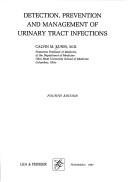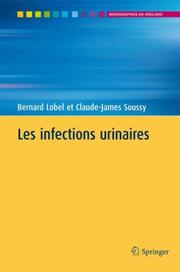| Listing 1 - 10 of 111 | << page >> |
Sort by
|

ISBN: 0812110463 Year: 1987 Publisher: Philadelphia (Pa.): Lea and Febiger
Abstract | Keywords | Export | Availability | Bookmark
 Loading...
Loading...Choose an application
- Reference Manager
- EndNote
- RefWorks (Direct export to RefWorks)
Book
ISBN: 1837682127 Year: 2023 Publisher: London : IntechOpen,
Abstract | Keywords | Export | Availability | Bookmark
 Loading...
Loading...Choose an application
- Reference Manager
- EndNote
- RefWorks (Direct export to RefWorks)
Urinary tract infections (UTIs) can disrupt lives, causing discomfort, frustration, and anxiety. Drawing on the latest medical research, expert advice, and real-life experiences, this comprehensive guide provides a roadmap to urinary health. From the underlying mechanisms of UTIs to the most effective treatments, you will gain a deep understanding of this common condition. Written by experts in the field, this book combines cutting-edge medical research with real-life stories and experiences, creating a valuable resource for patients, caregivers, and healthcare professionals alike. Whether you are seeking answers for your own struggles or supporting a loved one through their UTI journey, this book equips you with the knowledge and tools to make informed decisions and achieve lasting urinary health.
Urinary tract infections. --- Urinary tract infections --- Chemotherapy.
Book
Year: 2002 Publisher: Bruxelles: UCL,
Abstract | Keywords | Export | Availability | Bookmark
 Loading...
Loading...Choose an application
- Reference Manager
- EndNote
- RefWorks (Direct export to RefWorks)
L’infection urinaire de l’enfant est un véritable problème auquel le médecin généraliste est régulièrement confronté. En effet, le tractus urinaire est, après le système respiratoire (ORL y compris) et le système digestif, l’appareil le plus fréquemment infecté chez l’enfant.
Les symptômes classiques d’une infection urinaire sont rarement présents chez l’enfant et ce d’autant plus qu’il est jeune. Face à un enfant malade, on aura tendance à s’orienter vers des solutions simples.
Exemples :
1. En cas de température sans aucune plaintes, on verra plus facilement une gorge rouge et éventuellement, réalisera un frottis. Si la température persiste, on prescrira un antibiotique.
2. De même, on attribuera plutôt des maux de ventre et une perte d’appétit à des troubles digestifs.
Souvent, ce n’est que lorsque la situation traine ou en cas de récidives des plaintes que l’on pensera à effectuer une analyse d’urines.
Il n’est pas toujours simple de préciser la localisation de l’infection urinaire et d’en définir le mode de prise en charge (ambulatoire ou hospitalier) et le traitement. Cependant, il est nécessaire d’agir vite et de reconnaître les situation à risque afin d’éviter, en cas d’atteinte haute, les complications aiguës parfois graves (abcès, septicémie) et les complications chroniques (insuffisance rénale, hypertension artérielle, toxémie gravidique) dues aux cicatrices parenchymateuses (10 à 65 % des cas).
Il faut aussi avoir à l’esprit qu’une infection urinaire chez l’enfant peut être le premier symptôme d’une anomalie de l’arbre urinaire. Il est donc important de la rechercher
Book
Year: 2015 Publisher: Bruxelles: UCL. Faculté de médecine et de médecine dentaire,
Abstract | Keywords | Export | Availability | Bookmark
 Loading...
Loading...Choose an application
- Reference Manager
- EndNote
- RefWorks (Direct export to RefWorks)
Dans l'enfance, 1à 8 % des enfants développent une infection urinaire haute ou basse. (1, 2) Ces Infections sont 3 à 4 fois plus fréquentes chez les filles. La stase urinaire, favorisée par le reflux vésico-urétéral mais aussi par l'instabilité vésicale ou la vessie neurologique, est le premier facteur de risque de ces infections. (1-3) Les symptômes urinaires observés peuvent varier selon l'âge de l'enfant : fièvre (une température rectale ≥ 38.5°C), altération de l'état général, douleurs dorsales ainsi que des signes digestifs (inappétence ou des vomissements). En marge de ces signes et symptômes aspécifiques, les signes biologiques telles qu'une CRP ≥4 mg/dl et/ou une leucocytose >15 OOO/ mm3 peuvent être mises en évidence. (3) Le diagnostic d'infection urinaire nécessite une culture urinaire positive. (4-6) Escherichia coli est l'agent causal rapporté dans 80% des infections urinaires chez l'enfant . (2, 3)L'objectif de ce mémoire est double : d'une part décrire l'épidémiologie et le profil de résistance des germes rencontrés dans les infect ions urinaires des nourrissons de moins de 3 mois; d'autre part, analyser si le traitement empirique actuel utilisé aux Cliniques universitaires Saint-Luc est bien adapté à ce type d'épidémiologie. Pour y répondre, nous avons réalisé une étude descriptiverétrospective janvier 2011 - janvier 2014) sur les infect ions urinaires des nourrissons de 0 à 3 mois aux Cliniques universitaires Saint-Luc. Parmi les 221 enfants ayant eu un prélèvement urinaire positif, 53% (n=117) ont été considérés comme infectés. Les symptômes et signes retrouvés chez les enfants infectés sont la fièvre (29%), les vomissements (13.7%) et l'irritabilité (32.5%). f. coli est l'agent causal majoritaire retrouvé dans 77.9%. E. coli est résistant à l'ampicilline dans 51.9% des cas, à l'amoxicilline-clavulanate dans 42% des cas, au cotrimoxazole dans 21.3% des cas et à la cétazoline dans 63% des cas. Chez 9 enfants infectés (7.7%), on a cultivé une entérobactérie productrice de bêtalacamases à spectre étendu (BLSE) : E. coli (7 cas), Klebsiella pneumoniae (K. Pneumoniae) (1cas), Enterobacter cloacae (E. cloacae) (1 cas). Aucune résistance n'a été trouvée pour la témocilline. Vu les résistances rencontrées, le traitement empirique utilisé aux Cliniques universitaires Saint-Luc n'a pas lie u d'êt re modifié. Ce dern ier comprend l'association d'une aminopénicilline et d'une céphalosporine de 3ème génération (26.2%) (n=22) ou l'association d'une aminopénicilline avec de l'amukin (22.6%) (n=19). Dans la population des non infections urinaires, 27% ont reçu une antibiothérapie pour d'autres causes d'infections. Dans le bilan d'infection urinaire,25 ponctions lombaires ont été réalisées dont une était positive. During childhood, 1to 8% of children develop lower or higher urinary tract infection(UTI). UTI occur 3 to 4 times more frequently in girls than boys. Prolonged urinary retention is the main risk factor for UTI and is mainly caused by vesicoureteral reflux, bladder instability or neurological bladder disorders. (1-3) Symptoms and signs vary with the child's age: fever (rectal temperature ≥:38.5 °C), poor general state, back pain as well as gastro-intestinal complaints such as anorexia and vomiting. Accompanying these unspecific symptoms and signs are biological signs like elevated CRP (?:4 mg/dl) and/or leucocytosis (white cell count ?:15000/mm3 . (3) The diagnosis of UTI is defined by a positive urine culture. (4-6) E. coli is the main cause of infection, found in 80% of pediatric UTls. (2,3)Objective: The scope of this study is double: first to describe the epidemiology and resistance profile of bacteria involved in UTls, and second to analyze whether or not the empirical treatment currently in use at St-Luc University Hospital well suited to the prevalent infectious agents. To answer these questions, we have carried out a retrospective study (January 2011 - January 2014) on UTls in newborns (0 to 3 months old) at St-Luc University Hospital.Results: Among the 221 children with a positive urine culture, 53% (n= l7) were considered infected. Symptoms among the infected included fever (29%), vomiting (13.7%), and irritability (32.5%). E. Coli was the main cause of infection, found in 77.9% of cases. lt was resistant to ampicilline in 51.9% of cases, to amoxicilline-clavulanate in 42%, to cotrimoxazole in 21.3% and to cefazoline in 63%. Nine children (7.7%) were infected by extended-spectrum beta-lactamases producing enterobacteria (ESBL): 7 cases E. coti, 1case Kfebsieffa pneumoniae (K. Pneumoniae) and 1 case Enterobacter cloacae (E. cloacae). No resistance to temocilline was found. Based on these findings, empirical antibiotic treatment for pediatric UTI at St-Luc University Hospital should not be modified. This treatment is an association of on aminopenicillin and one 3th generation cephalosporin (26.2%) (n=22) vs. an association of on aminopenicillin and amukin (22.6%) (n=19). ln the population of non UTI, 27% received an antibiotherapy for other types of infections. ln the work up of UTI, 25 lumbar punctures were realized, one of then was positive.

ISBN: 2287251723 9782287251726 Year: 2007 Publisher: Paris: Springer,
Abstract | Keywords | Export | Availability | Bookmark
 Loading...
Loading...Choose an application
- Reference Manager
- EndNote
- RefWorks (Direct export to RefWorks)
Book
Year: 1967 Publisher: Leiden : Stafleu,
Abstract | Keywords | Export | Availability | Bookmark
 Loading...
Loading...Choose an application
- Reference Manager
- EndNote
- RefWorks (Direct export to RefWorks)
Book
Year: 1970 Publisher: Melbourne : Mercedes,
Abstract | Keywords | Export | Availability | Bookmark
 Loading...
Loading...Choose an application
- Reference Manager
- EndNote
- RefWorks (Direct export to RefWorks)
Book
Year: 1967 Publisher: Leiden: Stafleu,
Abstract | Keywords | Export | Availability | Bookmark
 Loading...
Loading...Choose an application
- Reference Manager
- EndNote
- RefWorks (Direct export to RefWorks)
Book
Year: 2019 Publisher: Lyon (FR) : International Agency for Research on Cancer,
Abstract | Keywords | Export | Availability | Bookmark
 Loading...
Loading...Choose an application
- Reference Manager
- EndNote
- RefWorks (Direct export to RefWorks)
Book
Year: 1972 Publisher: Baltimore Williams and Wilkins
Abstract | Keywords | Export | Availability | Bookmark
 Loading...
Loading...Choose an application
- Reference Manager
- EndNote
- RefWorks (Direct export to RefWorks)
| Listing 1 - 10 of 111 | << page >> |
Sort by
|

 Search
Search Feedback
Feedback About UniCat
About UniCat  Help
Help News
News